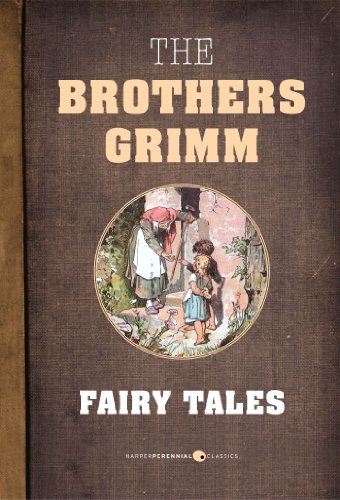-
The Wolf and the Seven Little Kids
The Brothers Grimm,
language (Dreamscape Media, Oct. 17, 2017)The Wolf and the Seven Little Kids is a fairy tale that strongly resembles The Three Little Pigs and elements of Little Red Riding Hood. In it, a mother goat leaves her kids home alone, warning them not to open the door. A Big Bad Wolf shows up and tries to talk his way in, but the kids hold fast. When the wolf finally gets past the door through trickery, he eats all but one of the kids. The mother goat returns to find the wolf sleeping under a tree. With the help of the one child who wasn’t eaten she rescues the remaining six with the help of a pair of scissors and some large rocks.
-
Hansel and Gretel
Brother's Grimm
eBook (, Jan. 5, 2012)Hansel and Gretel is a well-known fairy tale of German origin, recorded by the Brothers Grimm and published in 1812.The story follows a young brother and sister who discover a house of candy and cake in the forest and a child-devouring witch.This book features one of the cutest and loveliest illustration for children
-
The Complete Brothers Grimm’s Fairy Tales
Brothers Grimm
Paperback (CreateSpace Independent Publishing Platform, Dec. 5, 2015)The Brothers Grimm, Jacob (1785-1863) and Wilhelm (1786-1859) were German brothers who remained close friends, and both studied law. While Jacob went on to study philology, Wilhelm wrote. The two of them worked on creating a German dictionary, but it would not be finished until long after they were both dead.The Brothers would be lost to history, except they also collaborated on a collection of 200 fairy tales and published two volumes of them in 1812 and 1814. Although their intention was purely to preserve the material and try to keep the German culture and history alive, their collection proved to be massively popular with young children. The first English translation arrived in 1823, making them a must read for children ever since.
-
Grimms' Fairy Tales
the brothers Grimm
eBook (, March 24, 2020)Grimms' Fairy Tales, originally known as the Children's and Household Tales is a collection of fairy tales by the Grimm brothers or "Brothers Grimm", Jakob and Wilhelm, first published on 20 December 1812.
-
Grimm's Fairy Tales
The Brothers Grimm
Paperback (Independently published, Jan. 24, 2020)Grimms' Fairy Tales, originally known as the Children's and Household Tales, is a collection of fairy tales by the Grimm brothers or "Brothers Grimm", Jakob and Wilhelm, first published on 20 December 1812Few people alive today are unaware of the magical fairy tales told in this original collection of Children's and Household Tales. Tales that have gone on to inspire countless writers and movies such as, "Little Red Riding Hood", "Sleeping Beauty", "Snow White", "The Princess and the Pea", "Tom Thumb, "Hansel and Gretel" and "Rapunzel" to name just a few.This is a coming of age collection of short stories that no family should be without. Let your imaginations run wild as you read how the stories were meant to be told - you may realise the originals were darker than some colorful films would have you believe!
-
Fairy Tales: Illustrated Curated Classics!
The Brothers Grimm
eBook (, Aug. 10, 2015)Over 40 classic Fairy Tales, including favorites like Snow White, Rapunzel, Hansel and Gretel, Tom Thumb, Thumbelina, and so much more!
-
Hansel And Gretel
The Brothers Grimm,
eBook (Dreamscape Media, Oct. 17, 2017)In Hansel and Gretel, a famine has settled over the land. The children of a poor woodcutter are abandoned in the woods by their cruel stepmother who believes she and her husband will starve as a result of providing for the children. Days of wandering lead them to a beautiful cottage made of gingerbread and candy, which the children begin to eat. Lured inside by an old woman who promises hot baths, soft beds and more delicious food, the children are captured and enslaved by what turns out to be a cannibalistic witch. The resourceful children must rely on their wits to make a daring escape.
-
Rumpelstiltskin
The Brothers Grimm,
eBook (Dreamscape Media, Oct. 17, 2017)In “Rumpelstiltskin” a miller’s careless boast that his clever daughter can “spin gold from straw” is forced by the king to make good on this claim. A little man arrives to help the miller’s daughter in exchange for her firstborn child. When the daughter, who by now is the queen, gives birth to a child, the little man comes to collect. He agrees to release the queen from her promise if she can learn the imp’s name. According to researchers at Durham University and the Universidade Nova de Lisboa, this story originated around 4,000 years ago.
-
Fairy Tales
Brothers Grimm
eBook (HarperPerennial Classics, Dec. 4, 2012)Fairy Tales brings together many of Jacob and Wilhelm Grimm’s best-known and loved works, including “Rapunzel,” “Hansel and Gretel,” “Little Red Riding Hood,” and “Snow White and Rose Red.” HarperPerennial Classics brings great works of literature to life in digital format, upholding the highest standards in ebook production and celebrating reading in all its forms. Look for more titles in the HarperPerennial Classics collection to build your digital library.
-
Grimm's Fairy Tales
The Brothers Grimm
Paperback (CreateSpace Independent Publishing Platform, June 19, 2014)Children's and Household Tales is a collection of fairy tales first published on 20 December 1812 by the Grimm brothers or "Brothers Grimm", Jacob and Wilhelm. This collection is commonly known as Grimms' Fairy Tales among English speakers. The first edition contained 86 stories, but by the seventh edition, in 1857, there were 211 unique fairy tales. Jacob and Wilhelm Grimm were two of nine children from their mother Dorothea (Née Zimmer) and father Philipp Wilhelm Grimm. Philipp was a highly regarded district magistrate in Steinau, near Kassel. Jacob and Wilhelm were sent to school for a classical education once they were of age, while their father was working. They were very hard-working pupils throughout their education. They followed their father’s footsteps and started to pursue a degree in law. However, in 1796, their father died at the age of 44 from pneumonia. This was a tragic time for the Grimms because the family lost all financial support and relied on their aunt, Henriette Zimmer, and grandfather, Johanne Hermann Zimmer. At the age of 11, Jacob was compelled to be head of the household and provide for his family. After down-sizing their home because of financial reasons, Henriette sent Jacob and Wilhelm to study at the prestigious high school, Lyzeum, in Kassel. In school, their grandfather wrote to them saying that because of their current situation, they needed to apply themselves industriously to secure their future welfare. Shortly after attending Lyzeum, their beloved grandfather died and they were again left to themselves to support their family in the future. The two became hell-bent on becoming the best students at Lyzeum, since they wanted to live up to their deceased father. They studied more than twelve hours a day and established similar work habits. They also shared the same bed and room at school. After four years of rigorous schooling, Jacob graduated head of his class in 1802. Wilhelm contracted asthma and scarlet fever, which delayed his graduation by one year although he was also head of his class. Both were given special dispensations for studying law at the University of Marburg. They particularly needed this dispensation because their social standing at the time was not high enough to have normal admittance. University of Marburg was a small, 200-person university where most students were more interested in activities than schooling. Most of the students received stipends even though they were the richest in the state. The Grimms did not receive any stipends because of their social standing; however, they were not upset by it since it kept the distractions away. The first volume of the first edition was published in 1812, containing 86 stories; the second volume of 70 stories followed in 1815. For the second edition, two volumes were issued in 1819 and a third in 1822, totaling 170 tales. The third edition appeared in 1837; fourth edition, 1840; fifth edition, 1843; sixth edition, 1850; seventh edition, 1857. Stories were added, and also subtracted, from one edition to the next, until the seventh held 211 tales. All editions were extensively illustrated, first by Philipp Grot Johann and, after his death in 1892, by German illustrator Robert Leinweber. The first volumes were much criticized because, although they were called "Children's Tales", they were not regarded as suitable for children, both for the scholarly information included and the subject matter. Many changes through the editions – such as turning the wicked mother of the first edition in Snow White and Hansel and Gretel to a stepmother, were probably made with an eye to such suitability. They removed sexual references—such as Rapunzel's innocently asking why her dress was getting tight around her belly, and thus naively revealing to the witch Dame Gothel her pregnancy and the prince's visits—but, in many respects, violence, particularly when punishing villains, was increased.
-
Snow White and the Seven Dwarfs
The Brothers Grimm
eBookChildren's classic Fairy tale with many, instructive, differentiated pictures.
-
The Brothers Grimm: Grimm's Fairy Tales
The Brothers Grimm
eBook (epubli, Dec. 11, 2018)"Grimm's Fairy Tales" is a collection of German fairy tales by the "Brothers Grimm". Jacob and Wilhelm Grimm first published the tales in 1812. The work of the Brothers Grimm influenced many other collectors of fairy tales like the Russian Alexander Afanasyev, the Norwegians Peter Christen Asbjørnsen and Jørgen Moe, and the English Joseph Jacobs.Stories contained in "Grimm's Fairy Tales":•The Golden Bird•Hans in Luck•Jorinda and Jorindel•The Travelling Musicians•Old Sultan•The Straw, the Coal, and the Bean•Briar Rose•The Dog and the Sparrow•The Twelve Dancing Princesses•The Fisherman and his Wife•The Willow-Wren and the Bear•The Frog Prince•Cat and Mouse in Partnership•The Goose-Girl•The Adventures of Chanticleer and Partlet•Rapunzel•Fundevogel•The Valiant Little Tailor•Hansel and Gretel•The Mouse, the Bird and the Sausage•Mother Holle•Little Red-Cap (Little Riding Hood)•The Robber Bridgeroom•Tom Thumb•Rumpelstiltskin•Clever Gretel•The Old Man and his Grandson•The Little Peasant•Frederick and Catherine•Sweetheart Roland•Snowdrop•The Pink•Clever Elsie•The Miser in the Bush•Ashputtel•The White Snake•The White Snake•The Wolf and the Seven Little Kids•The Queen Bee•The Elves and the Shoemaker•The Juniper-Tree•The Turnip•Clever Hans•The Three Languages•The Fox and the Cat•The Four Clever Brothers•Lily and the Lion•The Fox and the Horse•Blue Light•The Raven•The Golden Goose•The Water of Life•The Twelve Huntsmen•The King of the Golden Mountain•Doctor Knowall•The Seven Ravens•The Wedding of Mrs. Fox•The Sala•The Story of the Youth•King Grisly-Beard•Iron Hans•Cat-Skin•Snow-White and Rose-Red